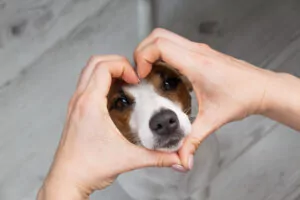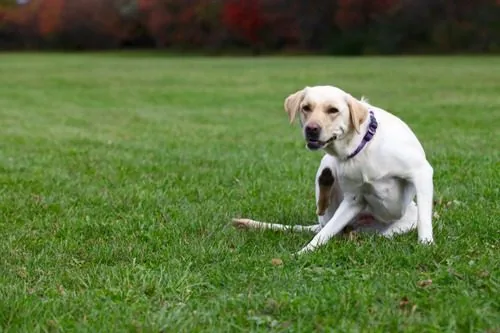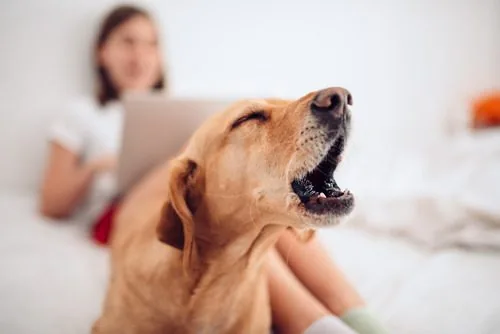What to Do If Your Dog’s Nose is Peeling
A dog’s nose is a crucial sensory organ that allows them to gather information about their surroundings. It’s not uncommon for dog owners to notice their canine companion’s nose peeling or developing cracks. What should you do if your dog’s nose is peeling?
If your dog’s nose is cracked and peeling, the first step is reaching out to your veterinarian. From there you will be able to find out the cause of your pup’s peeling nose, and you will be able to monitor and care for your furry friend.
In this article, we will explore the possible causes of your dog’s peeling nose, the steps you should take to address the issue, and how to prevent it from happening in the future.

Causes of a Peeling Nose in Dogs
There are a variety of reasons why your dog’s nose may be peeling. From the weather outside to allergies and infection, we will explore causes of a cracked and peeling nose.
Weather and Climate
Dry weather conditions, exposure to sunlight, and cold temperatures can all contribute to a peeling dog nose. These environmental factors can cause the skin on your dog’s nose to become dry, cracked, and ultimately peel. Sudden changes in temperature, humidity, or exposure to harsh weather can also exacerbate this issue.
Allergies
Allergic reactions to certain substances, such as plastic or rubber, can also cause your dog’s nose to peel. Your dog might be reacting to a new food dish, a toy, or something else in their environment that is causing an allergic response. In some cases, dogs can also experience seasonal allergies, which may lead to skin irritation, including on the nose.
Infection
Bacterial or fungal infections can cause your dog’s nose to become inflamed and peel. These infections can result from a weakened immune system, poor hygiene, or exposure to contaminated objects. Dogs with compromised immune systems or those who are prone to skin infections may be at a higher risk of developing nose-related issues.
Autoimmune Disease
Certain autoimmune diseases, such as lupus or pemphigus, can cause your dog’s nose to peel. These conditions cause the body’s immune system to attack healthy tissue, leading to skin issues and other symptoms. Diagnosing and treating autoimmune conditions can be challenging, making it essential to work closely with your veterinarian.
Trauma
Physical injuries or trauma, like scratches or abrasions, can also cause your dog’s nose to peel as the damaged skin begins to heal. Be mindful of your dog’s playtime and interactions with other animals to minimize the risk of injury to their sensitive nose area.
What to Do If Your Dog’s Nose is Peeling
Although consulting your veterinarian is the first step, addressing the underlying condition and providing care and monitoring your pup is important as well.
Consult Your Veterinarian
If you notice your dog’s nose is peeling, the first step is to consult your veterinarian. They can evaluate the issue and determine if it is due to an underlying health condition or a more benign cause, such as dry skin or weather conditions.
Address the Underlying Cause
Once your veterinarian has identified the cause of your dog’s peeling nose, it’s essential to follow their recommendations for treatment. This may involve the use of antibiotics or antifungal medications for infections, or immunosuppressive drugs for autoimmune conditions. In some cases, a change in diet or the use of supplements may be recommended to address nutritional deficiencies or support skin health.
Provide Proper Care
Depending on the cause of your dog’s peeling nose, your veterinarian may recommend specific care practices. These may include applying topical ointments or creams, using a humidifier to increase moisture in the air, or using a specialized pet-safe sunscreen to protect your dog’s nose from sun damage. It is important to follow your veterinarian’s instructions and monitor your dog’s progress throughout their treatment.
Monitor Your Dog’s Condition
Keep a close eye on your dog’s nose and overall health during the treatment process. If you notice any worsening of symptoms or new issues arising, contact your veterinarian for guidance. Regularly assess the condition of your dog’s nose and overall health during the treatment process. If you notice any worsening of symptoms or new issues arising, contact your veterinarian for guidance. It’s essential to track your dog’s progress and report any concerns to your veterinarian, as timely intervention can be crucial in resolving any potential complications.
6 Tips to Prevent Your Dog’s Nose from Peeling
1) Hydrate Your Dog
Ensure that your dog has access to fresh water at all times, as proper hydration is essential for maintaining healthy skin, including the skin on their nose. Dehydration can exacerbate skin issues and increase the likelihood of your dog’s nose peeling.
2) Maintain a Balanced Diet
A healthy diet can help support your dog’s immune system and overall health, reducing the risk of infections and other issues that could contribute to a peeling nose. Ensure that your dog is receiving the proper nutrients by feeding them a high-quality dog food that meets their specific dietary needs. Consult your veterinarian for recommendations on the best food for your dog’s age, breed, and activity level.
3) Protect Your Dog from the Weather
To help prevent your dog’s nose from peeling due to weather conditions, protect them from extreme temperatures and sun exposure. During cold weather, consider using a dog-safe balm on their nose to provide a protective barrier against the cold and dry air. When it’s sunny outside, apply a pet-safe sunscreen to your dog’s nose to prevent sunburn and skin damage.
4) Regularly Groom Your Dog
Keeping your dog clean and well-groomed can help prevent skin issues, including peeling noses. Regularly bathe your dog with a gentle, hypoallergenic shampoo, and pay attention to their nose during grooming sessions to monitor for any changes in its appearance or texture.
5) Monitor your Dog for Allergies
If your dog has a history of allergies, be vigilant about monitoring their environment and removing potential allergens. Regularly inspect their toys, bedding, and food dishes for signs of wear or damage, and replace any items that could be causing an allergic reaction.
6) Schedule Routine Veterinary Check-Ups
Regular veterinary visits can help catch and address health issues before they become more severe. During check-ups, your veterinarian can examine your dog’s nose for any signs of peeling or irritation and recommend appropriate preventative measures or treatments.
Conclusion
A peeling dog nose can be concerning for pet owners, but understanding the potential causes and taking the appropriate steps to address the issue can help your canine companion maintain a healthy, comfortable nose. Consult your veterinarian if you notice your dog’s nose is peeling, and follow their guidance for treatment and care.
For pet parents in the Atlanta, GA region, The Village Vets has 7 practices conveniently located across the Atlanta metro area. Find a location near you today!
Recent Posts
About The Village Vets
The Village Vets is a network of animal hospitals based in Atlanta, GA and the surrounding area. We offer honest, excellent service to our clients in a comfortable, friendly atmosphere. To learn more about our locations and how we can better serve you and your pet, click the button below.
Share This Post
Recent Posts
About The Village Vets
The Village Vets is a network of animal hospitals based in Atlanta, GA and the surrounding area. We offer honest, excellent service to our clients in a comfortable, friendly atmosphere. To learn more about our locations and how we can better serve you and your pet, click the button below.



